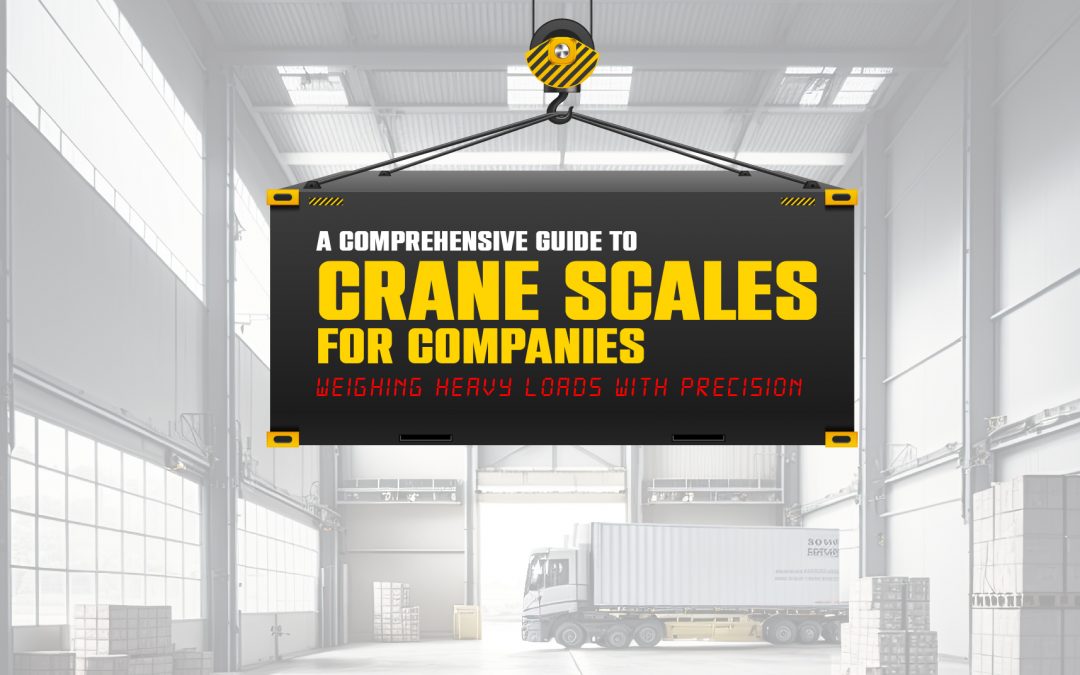Crane scales play a pivotal role across industrial settings, construction sites, warehouses, shipping yards, and beyond by allowing teams to safely and efficiently weigh large suspended loads. However, with so many models and features available, selecting the right crane scale for your application can feel overwhelming.
Understanding Crane Scales: The Basics
In their simplest form, crane scales utilize load cells and digital displays to provide precise weight measurements of objects lifted via hoist rings or other attachment points. Load values can help ensure proper loading, and compliance with vehicle weight limits, verify inventories, and prevent overloading equipment. Models range from compact precision scales to high-capacity industrial giants able to handle anything from 500 kg to over 100 metric tons depending on the application.
Types of Crane Scales: Finding the Perfect Fit
Crane scales come in various types, each with its features and capabilities:
Digital Crane Scales:
Digital scales display weight values on an easy-to-read screen. They commonly offer peak hold functionality to capture maximum load values and data output options.
Analog Crane Scales:
Analog crane scales utilize physical dial gauges to indicate weight. They withstand harsh conditions well but lack data connectivity.
Wireless Crane Scales:
Cutting cords, wireless models utilize Bluetooth or WiFi to transmit load data to devices like smartphones, tablets, and computers. This allows flexibility in positioning.
High-Capacity Crane Scales:
Heavy-duty scales with extra reinforced frames safely handle weights exceeding 10 tons. They are indispensable for shipping, construction, and mining settings.
Applications of Crane Scales: Where They Shine
The versatility of crane scales makes them indispensable in a variety of industries:
Construction:
Crane scales verify payload limits for lifting slings and equipment like cranes and forklifts are not exceeded, preventing catastrophes.
Manufacturing:
Factories leverage crane scales to carefully monitor assembly line input and output materials for inventory and compliance purposes.
Shipping and Logistics:
Accurately documenting freight weights ensures proper truck loading, weight distribution, and compliance with roadway weight restrictions during transport.
Mining:
Crane scales facilitate carefully tracking yields of extracted materials and monitoring equipment capacities.
Aerospace:
Precision models ensure balanced payload distribution for rocket assemblies transport and measure inertia before positioning sensitive components.
Benefits of Using Crane Scales: Efficiency, Safety, and Beyond
The integration of crane scales into lifting and weighing workflows delivers immense value through myriad benefits spanning enhanced efficiency, improved safety, and lower costs.
Greater Efficiency
By providing instant access to accurate weight measurements, crane scales accelerate decision-making across loading/unloading processes, inventory tracking, equipment capacity verification, and more without workflow disruption. The data integrates directly into recordkeeping eliminating manual transcription errors. Wireless models also allow flexible operation from any location instead of being tethered by cumbersome cables.
Enhanced Safety
Exceeding crane, vehicle, or floor weight limits poses tremendous risks to workers and expensive equipment damages or losses. Crane scales empower crews to proactively identify overweight loads before initiating dangerous lifts. Features like overload warnings provide additional protection against surpassing rated capacities through auditory and visual alerts. This prevents catastrophic accidents.
Reduced Injuries
The ultra-precise load data from crane scales minimizes injury risks associated with guessing item weights and overexertion when maneuvering loads manually. The scales facilitate better planning, and equipment selection and distribute workloads appropriately. Fewer handling strains prevent chronic or acute injuries.
Operational Insights
Many smart crane scales record invaluable peak load data during lifts. Collecting this time-series data provides unique operational insights through load trend analysis. Teams can pinpoint load exposures nearing equipment limits prompting capacity evaluation or areas where oversized equipment is underutilized revealing optimization opportunities.
Cost Savings
Preventing crane tipping accidents avoids expensive repairs and replacements alongside devastating productivity losses. High-capacity models also future-proof operations for handling growth. Additionally, accurate weight data means appropriately charging shipping fees instead of estimates. Materials quantities are precisely tracked as well down to gram levels in some cases to ensure accurate yields and margins. This boosts profits.
Regulatory Adherence
Within transportation settings, crane scales help ensure loaded containers and trailers remain within legal roadway weight limits to avoid fines or penalties when passing weigh station inspections. Serial numbers on scales also validate calibration status for audits.
Selecting the Right Crane Scale: Key Considerations
Choosing the appropriate crane scale involves evaluating several factors:
Capacity:
Determine maximum anticipated weights during lifts to choose an appropriately high-capacity scale with overhead.
Accuracy:
Model accuracy ranges from ±0.1% to ±5% of measured values. High-precision scales better inform small load decisions.
Environment:
Harsh conditions like extreme weather, vibration, or debris require durable construction. Also, consider wireless capabilities to eliminate messy cables.
Features:
Additional functionalities like peak hold, load averaging, memory recall, and connectivity methods all factor into scale utility.
Calibration and Maintenance:
Look for models with integrated calibration weights for periodic accuracy validation. Easily serviced designs ensure minimal downtime.
Safely Using Crane Scales
Precision weight data is only useful if lifting operations remain safe. Here are some key tips for safely using crane scales:
Proper Rigging:
Ensure load attachment points are properly fastened to the crane scale using quality hardware – an unsecured load is extremely dangerous.
Load Centering:
Position lifted objects directly beneath the crane hoist axis to avoid tipping moments during weighing.
Slow Lifting:
Make small, gradual hoist height adjustments when first weighing unknown loads in case capacity is exceeded to avoid sudden load cell impacts.
Overload Protection:
Select scales featuring overload alerts that trigger beyond capacity weights to avoid equipment failures under excessive loads.
Regular Inspections:
Visually inspect and test crane scales before each use checking for any signs of visible damage per OSHA regulations to identify potential failure points.
The Future of Crane Scales: Technology and Innovation
As technology continues to advance, crane scales are evolving to meet the changing needs of industries. Some emerging trends in crane scale technology include:
Integration with IoT:
“Internet of Things” connectivity allows remote equipment monitoring, control, and data access in real-time.
Cloud-Based Data Management:
Scales can interface with cloud platforms for convenient data offloading, backup, and analytics using AI to spot efficiencies.
Advanced-Data Analytics:
Onboard processing presents actionable load data insights to improve decision-making through load averaging, filtering, and visualization tools.
Enhanced User Interfaces:
Improved displays with smartphone-esque responsiveness, rugged touchscreens, and voice control promote ergonomic handling.
Conclusion
Crane scales form essential links in the supply chain, manufacturing, and construction operations by enabling accurate weight monitoring during material handling and equipment lifting. While choosing the right high precision, high capacity, or wireless crane scale model tailored to your unique environment and workflow requires careful consideration, the payoffs in safety, efficiency, and decision-making justify the effort. By combining robust crane scales with consistent safety precautions as outlined, organizations can keep productivity and profitability soaring while keeping workers out of harm’s way.













